13-21 February 2014. High in the Andes in Peru year after year the snow melts into rivulets forming creeks forming streams forming rivers. From the mountains the Rio Marañón flows north for a hundred kilometers or so before heading east for five hundred kilometers, at which point it joins the Rio Ucayali.
High in the mountains some thousand kilometers to the south a river begins its voyage north. As part of its journey, in a deep canyon, it curves around the citadel of Machu Picchu forming a natural defense on three sides. Further north it connects with another river, coming from the west, to form the Rio Ucayali, and eventually the Ucayali turns east.
About eight hundred kilometers directly inland from the coast of Peru the Rio Ucayali and the Rio Marañón merge to form the great Amazon River. It is here that the Amazon begins its more than six thousand kilometer journey to the sea.
It is far beyond the mountains at this point, close to the equator. Tropical. Half the year it rains torrential rains. The river rises by more than nine meters flooding the surrounding forest and creating many side rivers. Its width expands by forty kilometers or more. The Amazon area, a giant tropical forest and river basin covers more than five and a half million square kilometers, and here live more than one third of all known species in the world. It is truly epic in size and scope.
Those who live along the riverbanks in Amazonia are known as Ribereños. They are predominantly a mix of detribalized natives and mestizos, hardy and adaptable. In small towns or villages or individual farms, they live on a rich flood plain that undergoes colossal changes each season. The river is the focal point of their lives. It is used for washing, fishing, bathing and the water for cooking. There are no roads in the jungle. The rivers are their roads and they travel by dugout canoe or, when occasion demands, by the local river bus. Children learn how to operate a canoe from a very young age. Their livelihood depends largely on farming, fishing and hunting. They have intimate knowledge of the river and the flood plain, and male children learn early the intricacies of fishing. They really are Ribereños – people of the river. The river defines them, and their way of life.
A fisherman-farmer pulled up to the shore at his home with his catch of the day. His pigs and ducks come to investigate. He also has many chickens. He and his family have a large typical home on stilts. Wooden, half walls, thatch roof.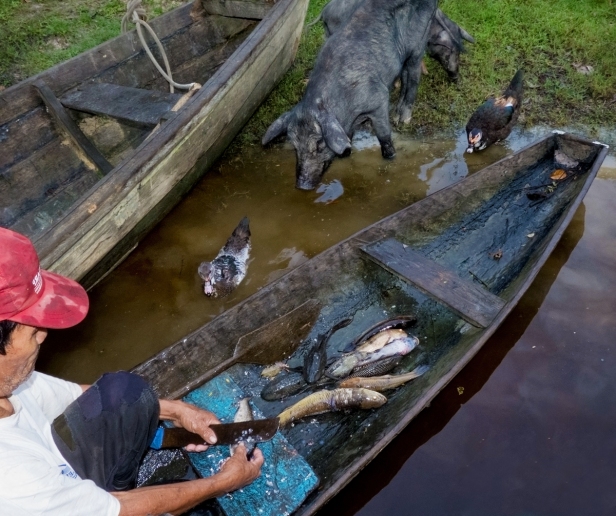
There is a village close to the lodge and we go to visit. The people are open and friendly and invite us into their simple homes. The children are shy at first but it doesn’t take them long to gather around us and start mugging for the camera. Later there is a soccer game. I don’t want to sugarcoat the situation. At the tiny store we meet the convivial town drunks playing cards as they drink the powerful local brew. Compared to the western world there is poverty here, perhaps particularly in the area of medical and dental care, but the atmosphere at the village seems light and friendly, the kids energetic and playful.
The village store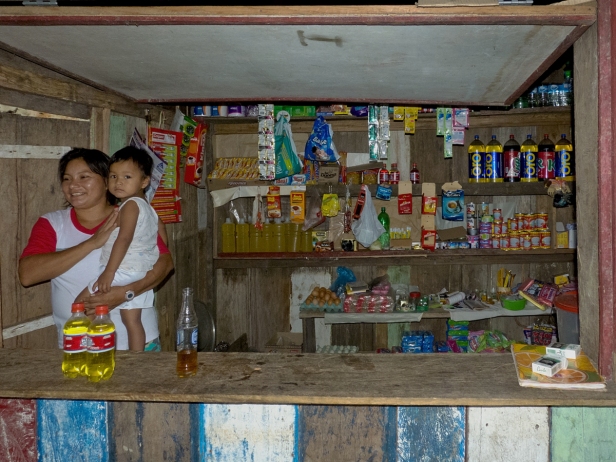
The children of the village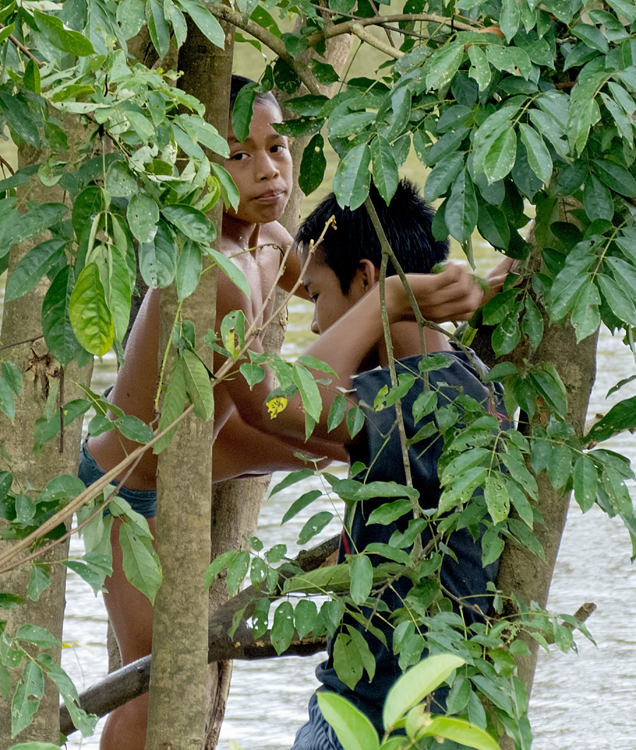



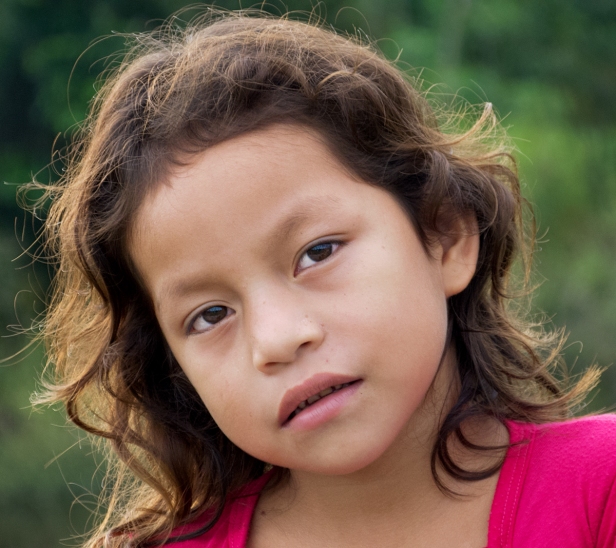
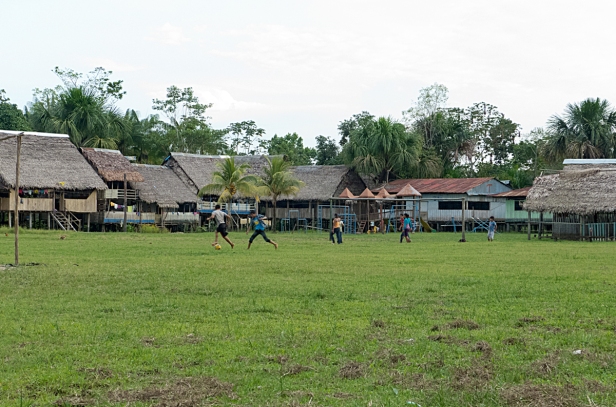
Sunset from the village – spectacular!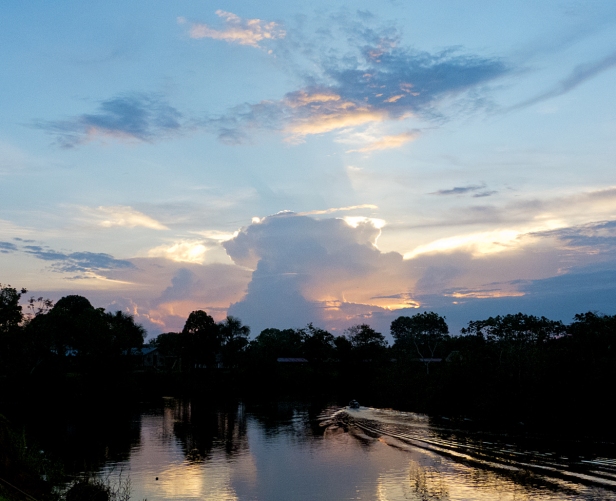
The river bus from Iquitos.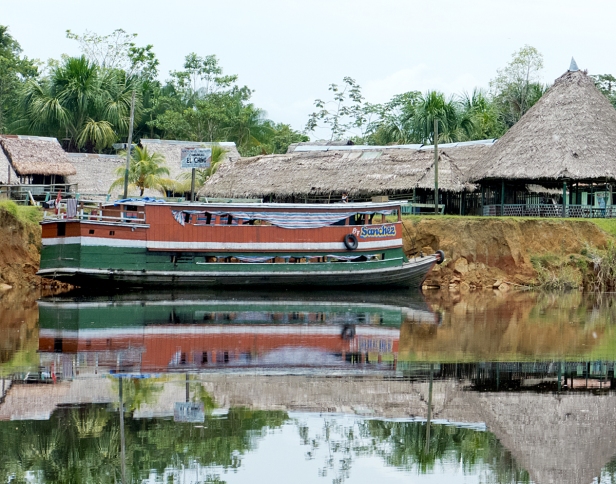
We are out exploring every day searching for life in the depths of the forest and in the canopy high above. We see:
dusky titi monkeys,
an aplomado hawk,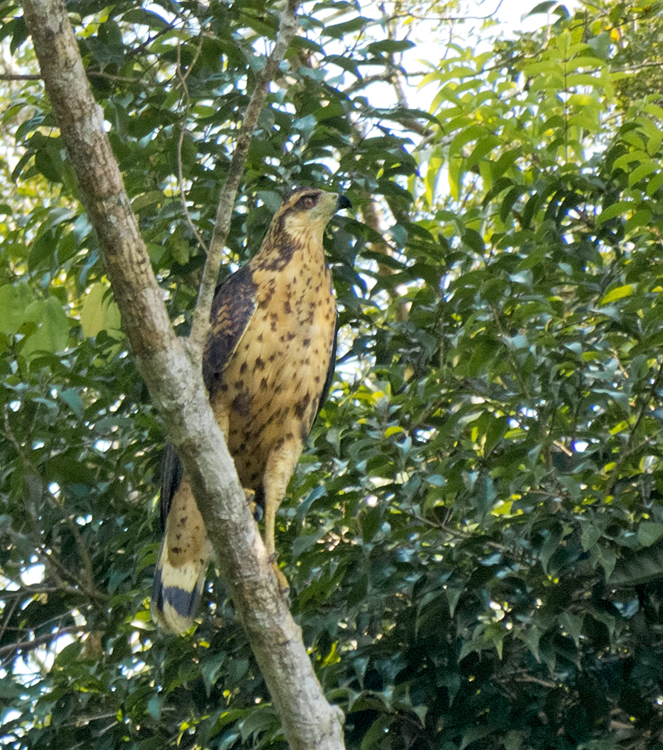
half a dozen tiny bats hanging off a tree,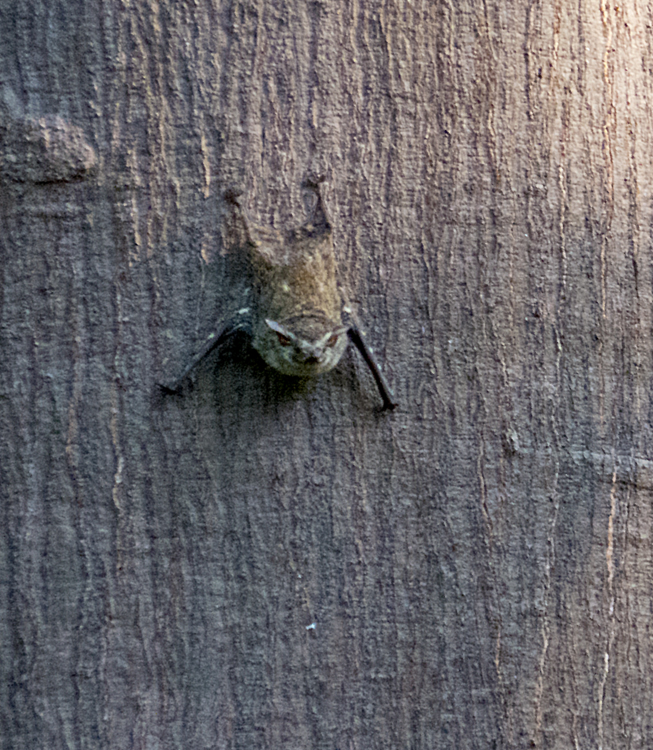
squirrel monkeys,
the brightest orange fungus I’ve ever seen,
black caracaras,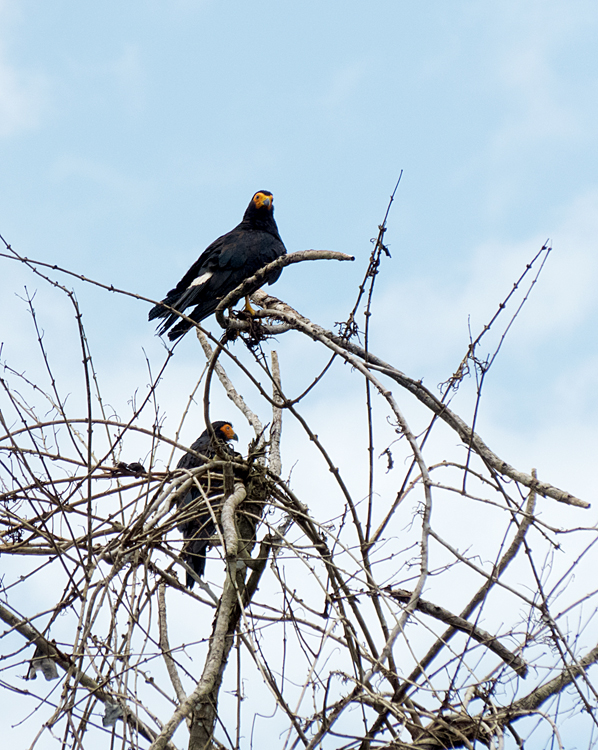
an emerald tree boa right in the grounds of the lodge,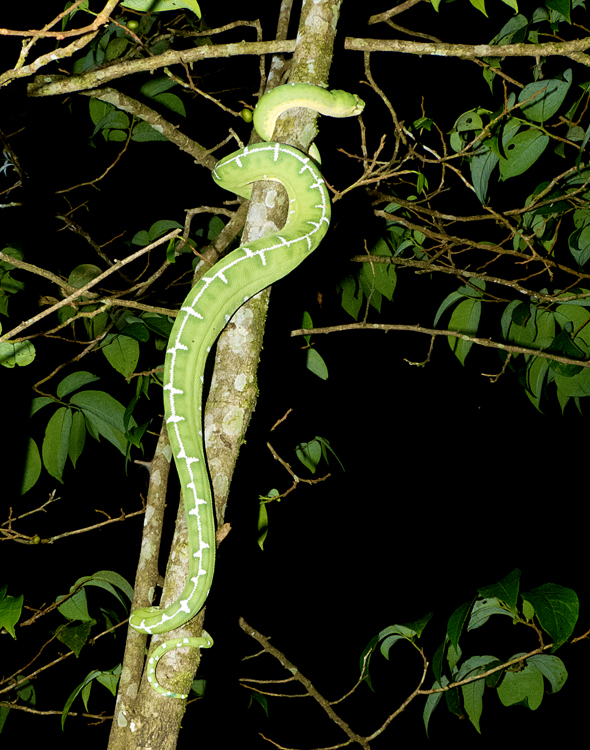
a highly poisonous caterpillar swimming in the river,
and on many occasions blue and yellow macaws.
Sloths are . . . . . slothful. They eat leaves. They sleep a lot. Once a week they come down to the ground to poop. Twice heading back to the lodge at dusk the boat slowed, then stopped, as the guides pointed out a sloth high in the trees. How they ever saw them astonishes me – nothing more than brown blobs, but expert eyes could pick them out. Then one day, in daylight we saw a baby, in full view and not so high up.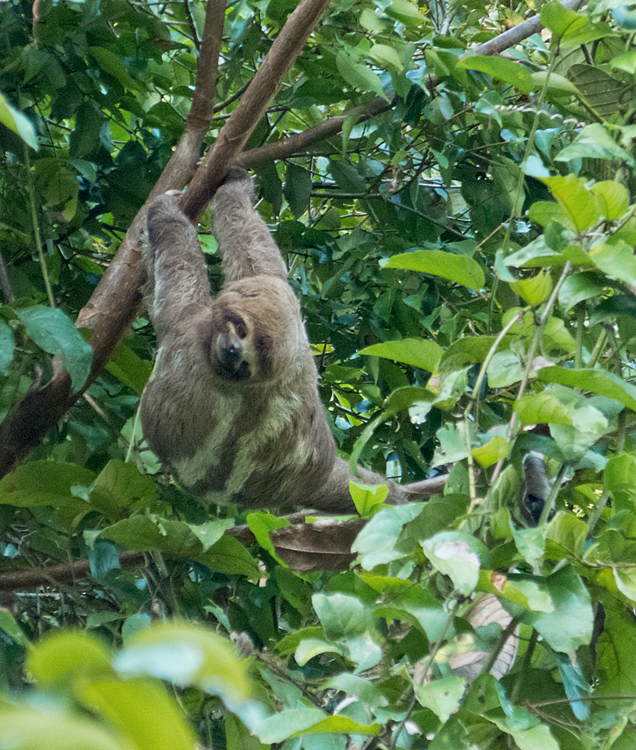
After five days at the lodge we went further up river to the Research Centre for four days. From there we set out to find the strange, unique and prehistoric hoatzin (watsin) bird. It eats fruit and leaves and has a digestive system similar to that of a cow. On our journey our guide becomes aware of howler monkeys high above clustered in the foliage. They’re not moving around much and we can’t see them. Next thing we know our boat driver grabs hold of some vines, and in bare feet starts using them to climb up the tree to encourage the monkeys to move so we can see them. He has to climb right to the top. It’s about fifty metres above us. He is fearless. We can hardly believe it. There we are standing around straining our necks trying to see the monkeys and suddenly this guy throws himself at the vines and starts climbing. Up and up and up. It was epic! Eventually the monkeys are disturbed enough to move and we catch glimpses of them leaping from tree to tree. They are powerful and majestic. They are entirely at one with their environment. As is the lithe and agile boat driver.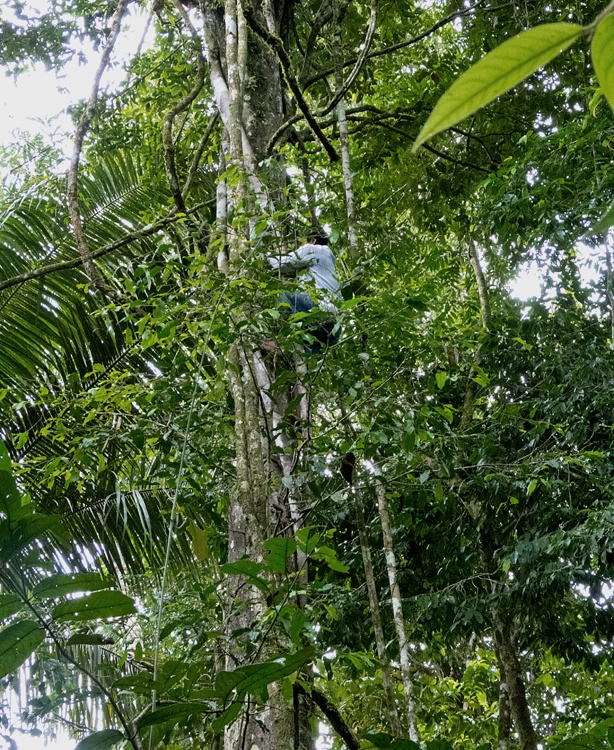
Further along the path I see this:
It is a fresh puma print. We see several of them along the trail. Our guide assures us they are old, from yesterday. I know better. It rained torrents last night.
Eventually we come to a tree with four or five hoatzin birds. They are quite far off on the other side of a lagoon, but we can see them well enough. They are exotic and beautiful.
And in the lagoon, practically hidden amongst the foliage, a caiman
Outside our room at the Research Centre is a tree filled with the nests of yellow-rumped caciques: a veritable high-density cacique village, dozens of them all crowded into one tree. We’d seen red-rumped caciques with the same crowding of nests in the jungle at Iguazu Falls.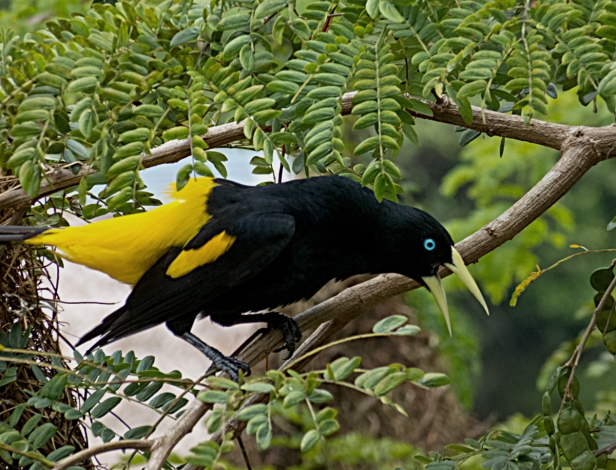
This is a wasp nest. The rings show how it has been added to over time. It is full of honey. Monkeys like to swing from it to bring it crashing to the ground to get the honey. They take turns swinging on it. When one feels it has been stung enough another takes over. Eventually one poor monkey is swinging on it when it gives way and he rides it to the ground or makes a flying leap to a nearby tree. I guess the payoff is worth the pain.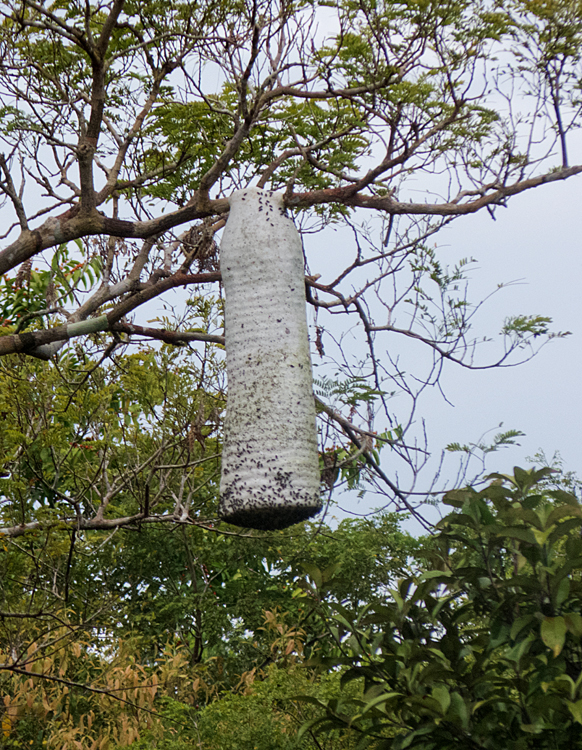
We went back to the village to visit the local shaman. He is a walking talking pharmacy. With our guide Cesar as interpreter we ask him many questions.
Ayahuasca is a brew of various psychedelic plant infusions that is used for spiritual and healing purposes by the native people of Peru. Like most psychedelics it reportedly opens the doors between this world and the world of spirit. On an ayahuasca journey one may learn of the spiritual nature of life, or of one’s true purpose, or of much that is not seen or known in every-day reality. Perception expands beyond the ordinary. I asked the shaman what he had seen and learned on his own ayahuasca journeys and he replied that he had learned about the medicinal properties of the plants of the jungle, to diagnose illnesses, and to understand which plants are needed for healing.
Early in the meeting, as we asked questions, he suddenly jumped up and went to get his medicine bag. He had fifteen bottles, each with a different plant or mix of plants, held in alcohol for preservation. There are over two thousand medicinal plants in the Amazon. He generally uses about one hundred of them. He explained the contents of each bottle – something for digestion, something for arthritis, something for female fertility, something for headaches, something for everything. He is the local doctor, bright and animated and passionate and extremely knowledgeable. We never did find out what the bunch of dried leaves is for. Or the hand-rolled ‘cigarettes’. Or the piece of wood. Or the stones. Or the matches. I imagine he’s danced a few wild dances in his time.
From the Research Centre we went to a large lagoon. A lone local fisherman came over to show us his catch. In his dugout behind him you can see a small part of his quite considerable haul for the day. In front of him is an electric eel, which he was careful not to touch. He brought it over for us to see it, and would later release it. Not surprisingly there is a taboo against eating electric eel. I love the clutter in his ragged boat. I love how completely at home he is in his environment. 
He also showed us this aptly named vampire fish,
and this piranha with its razor sharp teeth. The Indians used the teeth from a piranha to sharpen the darts for their blowguns.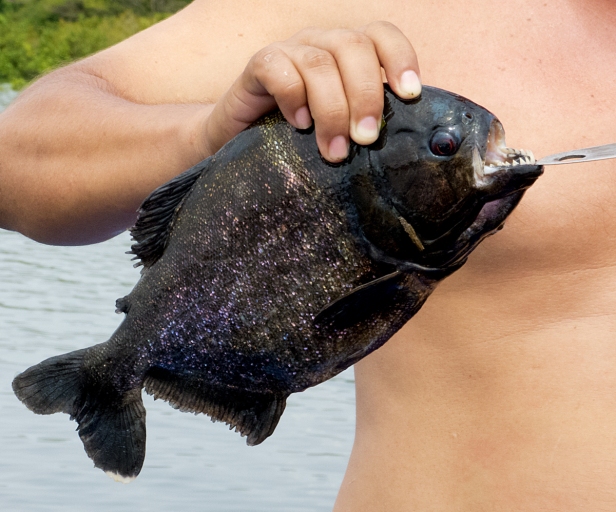
After this fishy show-and-tell we all dived in the warm-cool water and went swimming.
It was glorious. But the best part was the dolphins. They are an ancient species of river-dwelling toothed whale. During the dry season they live in the Amazon, during the wet they spread out wherever the water takes them. They range in colour from white to grey to vivid pink. To the people of the Amazon pink river dolphins are “boto” – shape-shifters that on the wings of your desire will steal your soul and take it to “encante”, an enchanted underwater world. And then we saw them. They were not close, but close enough to watch them breaching and to see their pink bellies. There is a reason they are called encantados, the enchanted ones. Just seeing them, and swimming in the same water was pure magic.
And wildlife we saw that I haven’t included or couldn’t photograph? Amazon-bamboo-rat white-winged-swallows herons mealy-parrots woodpeckers brown-capuchin pauraque roadside-hawk turkey-vulture black-fronted-numbird ringed-kingfisher masked-trogon squirrels black-vulture morpho-butterfly greater-ani crimson-tananger social-flycatcher muscovy-ducks wattled-jacamar terns and the blue-lipped-tree-lizard. A veritable smorgasbord of jungle wildlife.
The humidity high, the damp relentless, the air, our bodies, our clothes, dripping and sticky. Even clean clothes are clammy. Cold showers bring brief relief. I am covered in mosquito bites despite daily use of repellent and a net covering the bed. But the food is delicious. The company is fabulous. And every day is a feast for the senses, a discovery for the heart, a rich expedition to encounter the hidden secrets of the jungle. We wouldn’t have missed a second of it.
Next post: Back in the mountains again – the extravagant, wild, colourful, exotic two-week long Candelaria Festival of Puno, Peru. Dance til you drop!
All words and images by Alison Louise Armstrong unless otherwise noted
© Alison Louise Armstrong and Adventures in Wonderland – a pilgrimage of the heart, 2010-2015.
Paul Beaver’s Diary of an Amazon Jungle Guide. Paul is the founder of Tahuayo Lodge and the Tahuayo River Amazon Research Center. http://www.amazon.com/Diary-Amazon-Jungle-Guide-Encounters/dp/0972480919
An excellent article about the Ribereños. http://www.expeditions.com/destinations/south-america/amazon/the-experience/amazon-read-up-gear-up/staff-article8/
Sy Montgomery’s book Journey of the pink Dolphins: an Amazon Quest. http://symontgomery.com/?page_id=163

What an appropriate description for such a seemingly fascinating place!
LikeLike
Thank you so much. I’m glad you enjoyed it. It is indeed a fascinating place.
LikeLike
This post gave me gave me chills! Kevin and I begin out travels into the amazon in two weeks. Thanks for sharing your journey!!
LikeLike
Thanks Lexie. Oh you are going to have such a fabulous time! It’s an extraordinary place.
LikeLike
Mom and I were waiting for the posts about the Amazon, and your photos are – as always – simply stunning. I especially like the puma print, and the guy who scaled the trees to disturb the monkeys.
Having just started my own travel adventures, I have a whole new appreciation of how long it must take to single out a few images, and to put a narrative together with them.
LikeLike
Thank you so much Felicity. We couldn’t believe the guy who went up the tree. We were all just standing around looking up trying to see the monkeys and next thing he’s grabbed the vines and it hauling himself up. It was epic!
You are right – it takes a long time to choose which photos to use, and to put the whole post together, but I love the process so it doesn’t feel like work.
Now it’s time for me to head on over to your place and catch up with your travels.
Alison
LikeLike
Much as “civilized” children learn to negotiate the school bus stop, the crossing light, the grocery store, the mall, so children of the Amazon learn to pilot a canoe, to stay away from poisonous caterpillars and frogs and fish with teeth, and not to impale themselves on trees with thorns. Each totally adapted to the familiar.
Perhaps Don can answer this — does travel engage the “fight or flight” instinct? I remember from my own travels how enhanced my senses were while traveling, and Alison’s photos attest to a heightened awareness of color and her narrative notes changes in temperature, humidity. The brain seems to be on overdrive trying to take in all the stimuli. It’s energizing to totally experience travel in this way, but being on “heightened alert” for long periods is also, in my experience, very draining.
LikeLike
Yes that’s exactly right Pam – kids learn what they need to about the environment they’re in. I’ll let Don talk to you about about the fight or flight thing, but I do agree that my senses are heightened, and sometimes I feel completely saturated with all there is to take in – hence this time in Cyprus to recover. We were both completely exhausted, drained, brain dead by the 6 months in South America, and the last 2 weeks of it in Cuenca we’d just run out of steam and didn’t do much at all.
LikeLike
Hi Pam,
Don here about your excellent comments. What happens to me when I’m in unfamiliar and exotic places is that I become much more alert and present to whatever is going on around me than I do when I’m in familiar surroundings. Not really a flight or flight response, it’s just that the brain is constantly having to deal with new information. So you’re right about the senses being heightened, and that extended periods of that lead eventually to fatigue. Woo-hoo! followed by Oh woe!
LikeLike
Your photos are absolutely wonderful. What type of camera do you use?
Was your trip to the jungle pre-arranged with a tour company or did you just arrive there and arrange it on your own? That doesn’t seem so easy for that area.
LikeLike
Thank you re the photos. I use a bridge camera – a Panasonic FZ150 which I’ve had for about 2 yrs. I always avoided a full DSLR because of the weight. I’m upgrading to one of the new mirrorless cameras very soon. I won’t buy a Panasonic again – their after sales service is sh*t. Also the FZ150 is not good in low light.
We went on a preorganised tour with Amazonia Expeditions. There’s a link to their website at the bottom of the previous post on the Amazon. It was excellent and not very expensive. It was much more intimate and personalized than the river boat tours. I highly recommend them.
LikeLike
Fascinating pictures! I gasped when I saw the vampire fish and piranha! I don’t know if I could go swimming afterwards. 🙂 I’m enjoying following you on your journey! Cortneybre…
LikeLike
Thank you so much Cortney. I’m glad you’re enjoying our travels. Aren’t those fish something else! But we dived in anyway knowing they wouldn’t be interested in us. Piranha are only dangerous if there’s blood in the water, and vampire fish not at all I think.
LikeLike
Wow what an experience. I am planning to visit Brazil including the Amazon next year. I am very scared of snakes and spiders though. But the wildlife that you photographed looks amazing, and seems very diverse. By the end of my lifetime, I guess the Amazon will not look as it does not, so it’s important to me to see while it lasts. Thanks for giving me a good insight!
LikeLike
You must go, it is really incredible, and so worth it even if you’re scared of snakes and spiders. Honestly in the 9 days we were there no snakes and spiders ever came near us – we went to them, and walked away when we were done. It’s not like they come chasing after you. They like to hide. Going into the Amazon this way is not the same as staying in a nice hotel, but you get a very intimate experience. I understand there are river cruises, and probably this is even more likely from the Brazil side, where you can stay on a nice boat, and still get to see and experience *a lot* without being completely freaked out.
Alison
LikeLike
Beautiful story telling. We only spent 3 days in the Amazon basin in the Pampas which was spectacular but I would love to visit the Amazon jungle next time too, especially after reading this
LikeLike
Thank you so much. Glad you enjoyed the post. Do go to the jungle. It really is spectacular, an experience of a lifetime.
LikeLike
Great pictures. Amazing place but I would not go only with my girlfriend because its to dangerous I think. Only with a group of friends.
LikeLike
Thanks BH. Yes it is an amazing place, and definitely worth visiting. You could easily go only with your girlfriend as long as you have a guide. It was just me and Don and our guide most of the time. In fact you need a guide anyway, even if you are in a group. It would not be wise to just go walking around in the jungle (two people, or a group) without someone knowledgeable with you to show the way. Besides we would not have seen much without the guide. They are the ones who can spot things hiding in the trees. Hope you get there and have an amazing time! Alison
LikeLike
Five and a half million square kilometers! That number stopped me in my tracks, at the immensity of the Amazon. Amazing photos and narrative.
LikeLike
Thanks Angeline, I’m glad you enjoyed it. The Amazon basin is HUGE! We saw the tiniest tiniest part of it, and even so it was quite extraordinary. I’m so glad we went.
LikeLike
I only got to fly over the Amazon, so I appreciate the ground-level experience 🙂 I love the picture of the caiman – such a great contrast of textures and structures.
LikeLike
We wouldn’t have even known that caiman was there if the guide hadn’t pointed it out. He was quite incredible the way he could spot things in the foliage. The ground-level experience was spectacular!
LikeLike
Good read, very nice documentary photography!!!
LikeLike
Thank you so much nonoy, thank you for your lovely compliment. I’m glad you enjoyed the post.
Alison
LikeLike
Your pictures of Iquitos really takes me back. I haven’t been there in a few years. I first started going there as an anthropologist back in 1980. It has changed so much over the years. Yet, much is the same. Safe travels. Lucy
LikeLike
I’m sure it’s changed a lot, though I don’t know about Iquitos specifically, we didn’t spend any time there except to get in and get out. Does it refer to a region as well as the town? The village photos are of a village called El Chino, about 3 hours up river from Iquitos. Did you get there? It must have been extraordinary being there all that time ago, and as an anthropologist – you no doubt saw it with so much more depth than we did.
Alison
LikeLike
Yes, I’ve been to El Chino. Iquitos is not just the town Locals refer to Iquitos as being anywhere not more than a half day trip up and down the river. Sounds like you’re enjoying the area. Just be careful. Travel by boat only with other tourists or visitors, never solo with a guide.and or crew. Just a precaution. Enjoy. Lucy
LikeLike
We were with Amazonia Expeditions at Tahuayo Lodge, and the Tahuayo River Research Centre. We had a guide with us for the whole time we were there. We were very well taken care of.
LikeLike
I see you’re going to Puno. There’s a big indoor market there. Try and find the Puno hat. It’s brown, round top, broad brim and banded. You won’t find one you can afford in the States. At the festival, note the hats women wear. You can tell where they come from by their hats and whether they’re Aymara or Quechua. I’ve got this thing for hats. Enjoy the festival. Lucy
LikeLike
I got a thing for hats when I was down there too. It started in Bolivia when I first discovered that the hat denoted where a woman was from. The hats in Puno at the festival were extraordinary – so many varieties and so beautiful. We didn’t get to the market in Puno – too busy with the festival.
LikeLike
Whoa. Silly me. You’ve already been. I hadn’t noticed your location now in real time. Well, ignore all advice. Cyprus– I know Cyprus but was a long time ago before I got my doctorate. Ever read Lawrence Durrell? He wrote a great book on Cyprus, the way it used to be called “Bitter Lemons”. Enjoy Lucy
LikeLike
Yes we are in Cyprus. It’s lovely. I remember reading Lawrence Durrell many many years ago and loving his books, but can’t remember if I read “Bitter Lemons” or not. The blog’s about two or three months behind. We were in Puno early Feb, and Iquitos later in Feb. Since then went to Galapagos, and other places in Ecuador. I’ll eventually get it all caught up. I always put the dates that we were at the place I’m writing about at the beginning of the post.
LikeLike
Again, amazing! The countless, immensely exotic, birds you captured are unreal and so beautiful!
One of our mega desires is to some day do an Ayahuasca ritual with a Shaman in Peru. That Shaman you met seemed so interesting. I find it fascinating that there are people so inter-connected with nature that they can sense what will heal others. What a beautiful existence.
It’s amazing you saw all of those fish up close in the wild like that, how incredible. I don’t think there’s any other word for this particular place but just incredible!
Well done!!
~Andrea ❤
LikeLike
Thanks Andrea. It was all pretty incredible. We really enjoyed our visit with the shaman. He was very inter-connected with nature, and with spirit, and very soft spoken, grounded, and passionate about his vocation. I’d love to do an ayahuasca journey one day but you must be very very careful who you do it with. There have been some fake shamans and some people have died.
LikeLike
Yes, I think who you choose would be paramount – I’ve heard of disastrous experiences as well. It would be ultra important to have a strong recommendation, I’d imagine.
Do they recommend such things on tripadvisor? 🙂
LikeLike
I don’t know. I’d think if you google ayahuasca journey or something similar you’ll probably get heaps of info.
LikeLike
Sorry, it was tongue in cheek 🙂 – I was just trying to imagine what a typical tripadvisor review would sound like if it were about ayahuasca….how subjective could it get?!
~A ❤
LikeLike
Oh sometimes I’m just so darn literal. Chuckle. I love to read trip advisor reviews for this – bet it would make for some very interesting and/or amusing reading.
LikeLike
Aplomado Falcon. It is a set of words I used once in a now long gone post, very close to exactly a year ago, one of those words that comes to mind and you don’t know where you picked it up… How great to see the picture…! All of the pictures, actually…
I admire your courage in diving into the river after taking stock of the local electric eel population, and the dolphins sounded wonderful. Such richness of life. For some reason I am wondering what it would be like for the local fisherman with the eel in his boat to do a photo journal of the NY subway. The monkeys would be huddled around tablets out in the jungle, marveling at amazing diversity of the urban jungle, at the fearlessness of the local rats!
Michael
LikeLike
Thanks Michael. I must admit not one of us gave a second thought to electric eels, we were too intent on diving into that wonderful water.
I do like your image of the monkeys huddled over their tablets. Grinning and gesturing and gaping in amazement.
LikeLike
Lots of things in this post that I would never see in Virginia, like Piranhas with sharp teeth. Thanks for taking and sharing your great photos!
LikeLike
Thanks Mary, and you’re welcome. It was a truly amazing adventure. We’re very glad we went there.
LikeLike
Some beautiful photo’s. What an amazing place!
LikeLike
Thanks Amanda. Yes, it is a truly amazing place. I’m so glad we went there.
LikeLike
fabulous pics & posts, but yours always are!
LikeLike
Thanks Cindy. Yours are pretty fab too 🙂
LikeLike
Beautiful post! Fascinating. We felt the magic of the pink dolphins too!
LikeLike
Thanks Shirley. As you discovered yourselves it’s a fascinating place. I envy you that you saw a really really *pink* pink dolphin 🙂 but it was still a pretty special experience.
LikeLike